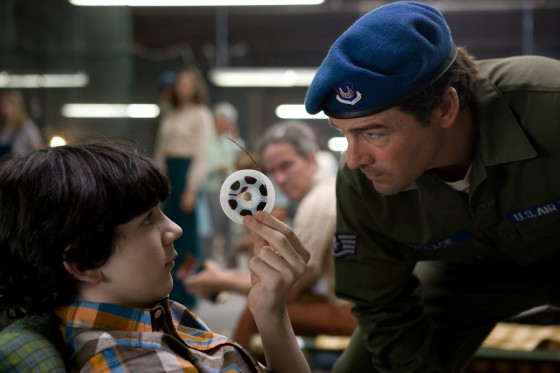New footage is out for Super 8, leading up to the June 10 theatrical opening. We are told a little more footage from this close-wrapped production will be released tonight at the MTV Movie Awards.
This website has a clip from the train crash. It's a reverse angle of the ad that aired during the Super Bowl. (I linked to that ad here.)
So now we know that the teens at the center of the movie are filming a scene for their zombie movie at an old train station in the town of Lillian, timed to use the passage of a freight train for ambiance. Then, a few hundred yards past the station and in the middle of their dialogue, the train derails.
Alarmed by a chain-reaction effect in which the point of derailment moves backward, causing freight cars halfway along the train to go off the rails at the station itself, the kids sprint for cover. In the confusion the camera flops onto its side, aiming at the wreckage. This found-footage is the plot device that pins the teens to the action.
The term Super 8 refers to an Eastman Kodak brand of 8mm movie film. See this Popular Science article from 1965, the first year it went on sale. Super 8 film stock is the same width as standard 8 mm, but the perforations are smaller. Kodak used the freed-up space to expand the image and also leave room for a sound stripe. Kodak first put sound-striped film stock on the market in 1973. See this Popular Mechanics article about the "revolution."
As depicted in the movie, the user could slap in a cartridge and be yelling "action" just seconds later. Standard movie cameras, such as the Bell & Howell 16mm camera I played around with, required the user to open up side of the camera, mount the reel of fresh film, and feed a leader through a sprocket drive to a takeup reel, making sure there was enough slack in the loops to avoid the sprocket gears stripping out the perforations. Depending on the speed chosen in frames-per-second, a cartridge with 50 feet of Super 8 film stock allowed two and a half minutes to three and a half minutes of shooting. Here's a shot of one of the actors holding up a developed reel.
Though VHS and subsequent videocameras blew up the home market for Super 8 film and cameras, Super 8 was a fine system for its day and much more commercially successful than Polaroid's Polavision instant-movie system, remarkably innovative but also remarkably ill-timed given the rise of affordable, capable home video.
Some low-low budget filmmakers actually shot entire features in the Super 8 format after the sound-striped version was available.
I'm predicting the JJ Abrams movie will do well, particularly given the lame competition this summer. Or maybe I just like the trains 'n aliens genre!


No comments:
Post a Comment